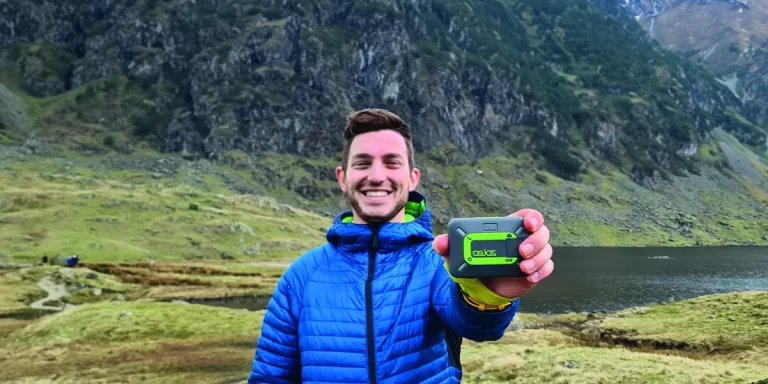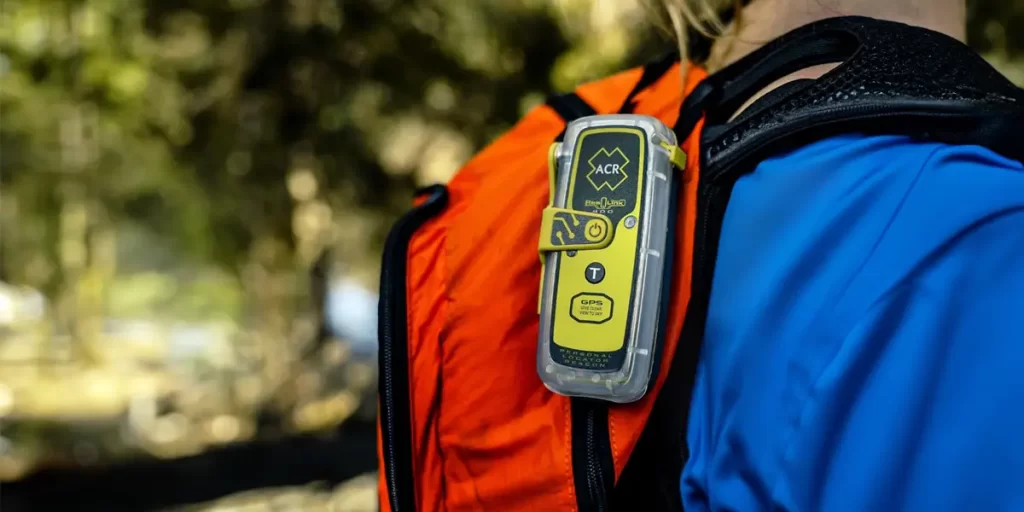

Picture yourself hiking or backpacking in a remote area when a sudden emergency strikes – you’re lost, injured, or facing a daunting situation.
That’s where a personal locator beacon (PLB) or a satellite messenger becomes your lifeline.
In this guide, we’ll explore the PLB vs satellite messenger debate. We’ll look closely at these devices to help you decide which emergency communication option is right for you.
Interested? Let’s get started.

PLBs are emergency devices that allow you to send out an SOS signal, alerting search-and-rescue services with the push of a button in areas without cell service.
These devices are built to withstand harsh conditions, equipped with long-lasting batteries that endure for ~5 years, making them suitable for even the most challenging environments, from dense forests to remote deserts.
When you trigger a PLB, it initiates a distress signal that travels to satellites orbiting high above Earth.
This signal is then transmitted to a coordination center along with your precise location and essential information, which is subsequently passed on to the relevant authorities, such as local law enforcement or search and rescue teams.
Certain PLBs utilize government satellites, eliminating the need for a subscription, and can pinpoint your location within 100 meters. They offer continuous location updates to rescuers, even if you’re on the move.
Where PLBs fall short:
PLBs transmit your location and personal details, but that’s the extent of their functionality. There’s no confirmation of message receipt, no option for custom messages, and you won’t get responses.
Some PLBs might encounter signal errors; placing them in an open area or on the ground can assist in achieving a GPS lock.

If you want more than just an SOS, consider one– or two-way satellite messengers. These devices can track your location and send messages.
One-way satellite messengers elevate your communication options beyond PLBs. They use private satellite networks and often involve subscriptions, similar to cellphone plans.
These devices offer more than just SOS; you can send customized messages to your loved ones, making it easy to stay in touch while off the grid. Simply set up your messages and contacts before your outdoor adventure, then choose the message and recipient when you’re out of reach of regular cell service. However, as with PLBs, you don’t receive any confirmation or response in return.
If one-way satellite messengers are a step up from PLBs, two-way satellite messengers take things even further by enabling both sending and receiving messages. These messages can originate from the rescue dispatch team or your friends and family, keeping you connected in critical situations.
Two-way satellite messengers come in two main types, each offering its own unique features and benefits:

As you can see, PLBs and satellite messengers have similarities but distinct differences. PLBs focus solely on safety, while satellite messengers offer additional conveniences.
Here’s a quick comparison table for you to get a better grasp:
| Feature | PLBs | Satellite Messengers |
|---|---|---|
| Purpose | Primarily for sending distress signals and SOS | Send messages, share location, communicate |
| Network | Use government operated satellites like COSPAS-SARSAT | Rely on private satellite networks |
| Cost | $150-$400 | $250-$500 |
| Subscription | Usually not required | Required monthly or annual fee |
| Battery Life | Long, up to 5 years | Shorter, depends on usage |
| Weight | Similar | Similar |
| Location Accuracy | Within 330 feet (100 meters) typically | Varies, can be 30 feet (10 meters) to 2 miles |
| Communication | One-way, cannot receive messages back | One or two-way, can receive messages |
| Message Types | Just SOS alert | Custom messages, chat, share waypoints |
| Ease of Use | Simple, press button to activate | More complex interface |
| Durability | Very rugged, usually waterproof | Design related reliability issues are more common, waterproof options exist |
Now that we’ve covered these devices, let’s find the perfect one for your hiking or backpacking adventures. Which one should you choose?
From our experience you should:
For inspiration, here are some popular ultralight PLBs and satellite messengers that won’t weigh down your backpack:
| Make / Model | Type | Weight (g) |
|---|---|---|
| ACR Bivy Stick | Satellite Messenger | 3.53oz (100) |
| Garmin inReach Mini 2 | Satellite Messenger | 3.53oz (100) |
| Zoleo Satellite Communicator | Satellite Messenger | 5.29oz (150) |
| ACR ResQLink 400 | PLB | 5.08oz (144) |
| SPOT Gen4 | Satellite Messenger | 5oz (142) |
Personal locator beacons (PLBs) and satellite messengers play a vital role in the wilderness. PLBs are simple and offer SOS assistance, while satellite messengers provide extra features.
Comparing them, PLBs win in battery life and running costs, while satellite messengers excel in providing peace of mind.
When should you carry these devices? Take them to remote, no-service areas and on solo trips. They act as safety nets, ensuring you can call for help when needed, even in areas without cell service.
These devices are like your safety insurance, ready to come to the rescue when situations get challenging, and next to a reliable navigation solution they’re among the most valuable gear investments you can make.
Interested in a PLB or a satellite messenger? Check out our TOP 5 guide to the lightest devices on the planet.
Carrying a PLB or a satellite messenger is like having a safety net for your outdoor adventures. If you’re going on a hike, especially in areas where your mobile phone signal disappears, having one of these devices is a smart move. It ensures you can call for help when you’re out of reach from regular communication. You never know when you might need help.
As a hiker venturing into remote backcountry areas, I look for certain key features when choosing a reliable personal locator beacon. It needs a sturdy, waterproof build to withstand rough terrain and weather. Long battery life of 5+ years ensures the PLB will work even after years stored in my pack. I want built-in GPS for accurate location data, a powerful 406 MHz transmitter to connect with satellites, and easy one-handed activation if injured. Reflective strips help rescuers visually locate me, while a homing transmitter guides them close once in range. Finding a lightweight model with these crucial reliability, signaling, and visibility features gives me peace of mind that my PLB can quickly summon emergency help from anywhere on the trail.
Personal locator beacons (PLBs) are highly reliable emergency devices that use satellite networks to transmit distress signals and location data to search and rescue authorities. Their rugged, waterproof design, integrated GPS, powerful transmitters, and long battery life allow PLBs to provide accurate location information to rescuers anywhere on Earth as long as they have a clear view of the sky. PLBs have proven their effectiveness in real rescues, demonstrating their vital role in outdoor and marine safety thanks to their robust and dependable signaling capabilities. In 2021, PLBs helped rescue 106 individuals in the US alone.
Satellite messengers use multiple satellite networks like Iridium and Globalstar to enable reliable global coverage from extreme environments. Their rugged, compact build includes powerful transmitters, heat/water resistance, and long-life batteries for weeks of operation. By combining GPS receivers with satellite-optimized antennas, they can accurately transmit text, SOS alerts and GPS coordinates from anywhere. Two-way messaging provides confirmation of received emergency messages. Their proven effectiveness for real-world rescues demonstrates satellite messengers offer unmatched reliability for emergency signaling via robust satellite connectivity.